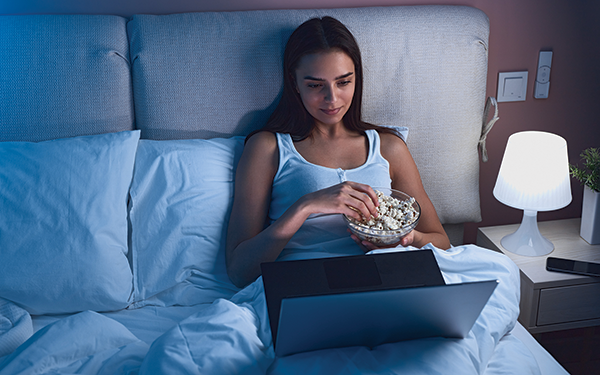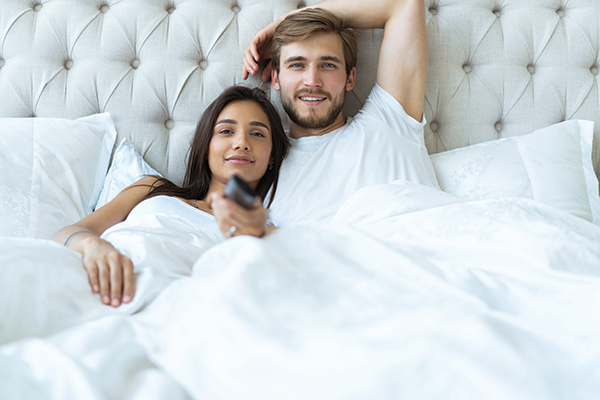New research from the Better Sleep Council reveals the habits and environmental factors getting in the way of a good night’s sleep.
For many, it’s a familiar feeling. Instead of waking up refreshed, there’s a sense of sluggishness — the result of either not enough or inferior sleep. According to the latest research from the Better Sleep Council, which leads consumer research and education for the International Sleep Products Association, a whopping eight in 10 adults report being less than satisfied with the quality of their sleep. What’s keeping the majority of people up at night? Or preventing a sound night of slumber? The research takes a closer look at a multitude of influences, including environmental, hereditary and lifestyle factors.
Below are some takeaways from the online survey, compiled using data from 1,005 respondents ages 18 or older.
Picture of health

When surveyed, nearly half of the respondents (48%) admit to feeling as though they don’t get enough sleep, unsurprising given that 53% of adults admit to getting six hours of sleep or less, on average. Of those who report being the unhappiest with their sleep quality, 36% describe themselves as being in poor or fair health. Conversely, within the 19% of those who stated they were very satisfied with their sleep, 72% said that they are in very good or excellent health.
Generation Gap
Although the specific impediments to a solid night of shuteye vary widely by age, physical discomfort is the prevailing factor reported by 60% of adults. That discomfort includes body pain, aches or uncomfortable temperature. For both baby boomers and Gen Xers, physical sensations are the most likely culprit of a bad night of sleep (43% and 42%, respectively). While physical discomfort is also in the top three causes of a bad night’s sleep for Gen Z and millennials, anxiety about money takes the top place for them (39% and 38%, respectively).
A whopping eight in 10 adults report being less than satisfied with the quality of their sleep.
To combat some of these impediments, 81% of adults (regardless of generation) take some steps during the day to try to ensure better rest. Almost a third report exercising during the day, while 40% strive to maintain some kind of sleep routine, whether it’s falling asleep or waking up at the same time or both. A little more than 40% adapt their technology and media habits at night because using them can disrupt both the quality and duration of sleep. Some tactics employed include not watching TV in bed (20%), not using a phone or tablet (17%) or switching personal devices to “dark mode,” which reportedly promotes better rest and minimizes eye strain. The latter method, however, has a skewed following, with Gen Z the largest adopters of dark mode (40%), compared with one-quarter of millennials, 18% of Gen X and only 8% of baby boomers.
Family affair
Of the parents surveyed, 60% of those with children under the age of 18 report that they sleep six or fewer hours per night, with 49% stating that it is very or somewhat difficult to fall asleep, compared with nonparents (42%). Women are also more likely than men to face sleep challenges with one-half reporting it is more difficult for them to fall asleep and stay asleep (55%), while also feeling as though they do not get enough sleep (54%).
Women are most commonly affected by four factors: body aches and pains (45%), a snoring partner (20%), and nighttime interruptions such as being woken up by pets (18%) or children (15%). Two in 10 adults admit to sharing their bed with at least one pet every day or nearly every day. And when it comes to partners, four in 10 adults (43%) sleep with a partner every day or nearly every day.
Hive of activity

Although designed for one distinct purpose, beds have evolved into command centers of sorts, accommodating a flurry of activity, such as watching TV, meditating, doing work or even eating and drinking. Three-quarters of U.S. adults use a smartphone in bed a few times per month or more. Of those who use their phone in bed, 71% are browsing or posting on social media apps. Another 60% consume video content in bed including streaming services or TV and 33% listen to music, podcasts or other audio content.
Eight in 10 adults read in bed several times per month, although the format varies. For Gen Z, millennials and Gen X, reading content on a smartphone tops the list, while the most popular medium for boomers is a printed book, magazine or newspaper. Whether in analog or digital formats, 33% of respondents report reading in bed weekly. Though the preceding statistics refer to consuming content for leisure, one-third of Gen Z and one-tenth of millennials report doing schoolwork in bed.
What are some solutions? We know a new mattress is helpful. When selecting a mattress, 72% of U.S. adults report that comfort is the most important quality they seek, followed by low price (13%) and the reputation of the mattress brand (8%). For the minority of adults (14%) who report being satisfied with their sleep, their top consideration in selecting a mattress is the reputation of the mattress brand.
Beds have evolved into a command center of sorts, accommodating a flurry of activity.
This latest research from the Better Sleep Council reveals myriad factors that influence the length, quality and duration of the average person’s sleep. It also underscores the importance of people taking advantage of factors within their control such as purchasing a high-quality, comfortable mattress and replacing it by the time it reaches the end of its useful lifespan for more restful nights.






